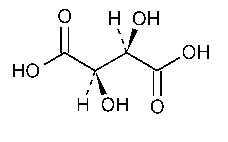Tartaric Acid
Butanedioic acid,2,3-dihydroxy-;Butanedioic acid,2,3-dihydroxy-,[R-(R*,R*)]-.
Tartaric acid;L-(+)-Tartaric acid [526-83-0]and [87-69-4].
»Tartaric Acid,dried over phosphorus pentoxide for 3hours,contains not less than 99.7percent and not more than 100.5percent of C4H6O6.
Packaging and storage—
Preserve in well-closed containers.
Identification—
A:
It responds to the tests for Tartrate á191ñ.
B:
When ignited,it gradually decomposes,emitting an odor resembling that of burning sugar (distinction from citric acid).
Loss on drying á731ñ—
Dry it over phosphorus pentoxide for 3hours:it loses not more than 0.5%of its weight.
Residue on ignition á281ñ:
not more than 0.1%.
Limit of oxalate—
Nearly neutralize 10mLof a solution of it (1in 10)with 6Nammonium hydroxide,and add 10mLof calcium sulfate TS:no turbidity is produced.
Sulfate á221ñ—
To 10mLof a solution (1in 100)add 3drops of hydrochloric acid and 1mLof barium chloride TS:no turbidity is produced.
Heavy metals,Method IIá231ñ:
0.001%.
Organic volatile impurities,Method Iá467ñ:
meets the requirements.
Assay—
Place about 2g of Tartaric Acid,previously dried and accurately weighed,in a conical flask.Dissolve it in 40mLof water,add phenolphthalein TS,and titrate with 1Nsodium hydroxide VS.Each mLof 1Nsodium hydroxide is equivalent to 75.04mg of C4H6O6.
Auxiliary Information—
Staff Liaison:Catherine Sheehan,B.Sc.,Scientist
Expert Committee:(EMC)Excipients:Monograph Content
USP28–NF23Page 3097
Phone Number:1-301-816-8262
